stop start TOYOTA SEQUOIA 2014 2.G Owner's Manual
[x] Cancel search | Manufacturer: TOYOTA, Model Year: 2014, Model line: SEQUOIA, Model: TOYOTA SEQUOIA 2014 2.GPages: 668, PDF Size: 13.86 MB
Page 560 of 668
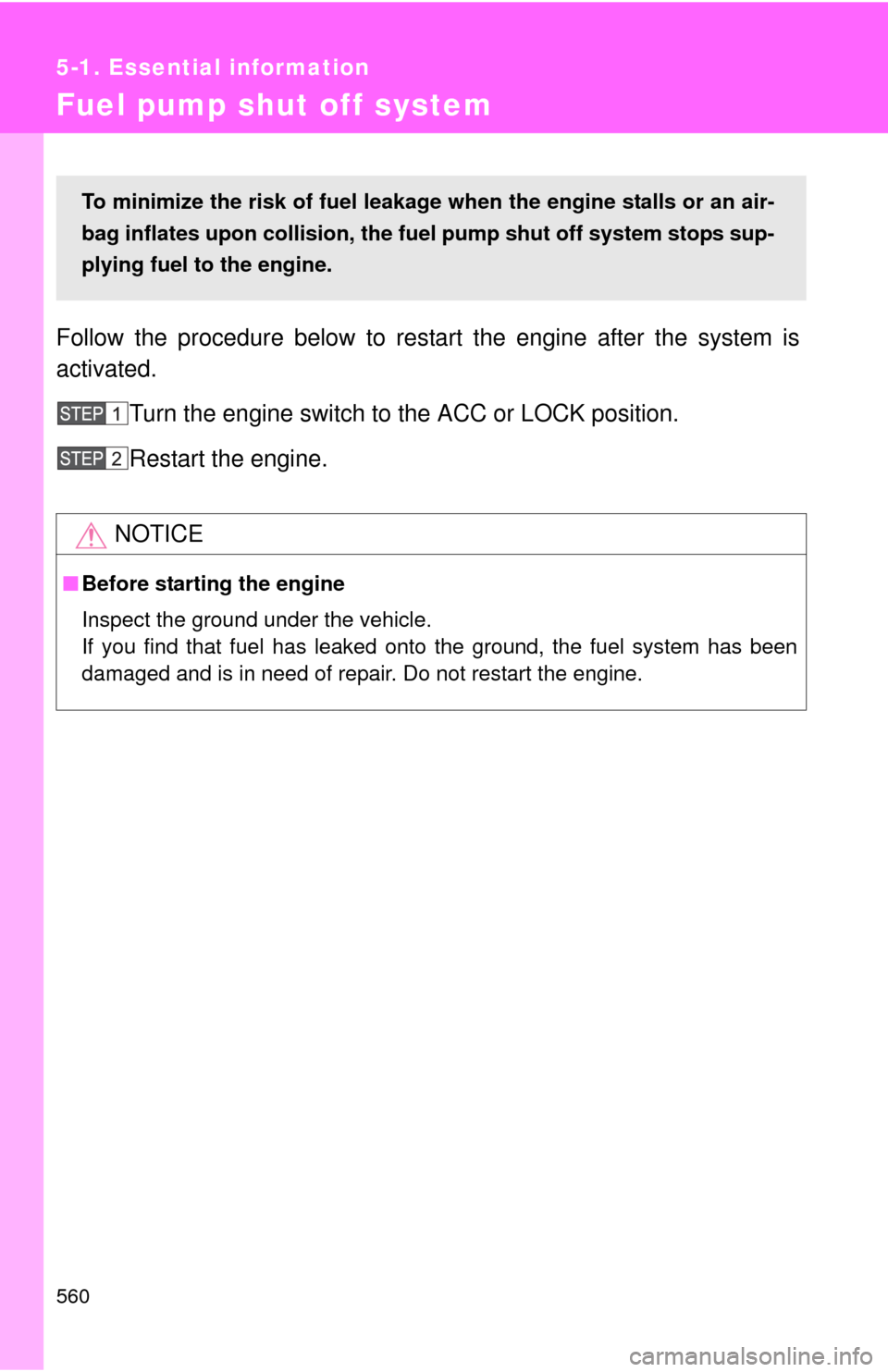
560
5-1. Essential information
Fuel pump shut off system
Follow the procedure below to restart the engine after the system is
activated.Turn the engine switch to the ACC or LOCK position.
Restart the engine.
NOTICE
■Before starting the engine
Inspect the ground under the vehicle.
If you find that fuel has leaked onto the ground, the fuel system has been
damaged and is in need of repair. Do not restart the engine.
To minimize the risk of fuel leakage when the engine stalls or an air-
bag inflates upon collision, the fuel pump shut off system stops sup-
plying fuel to the engine.
Page 564 of 668
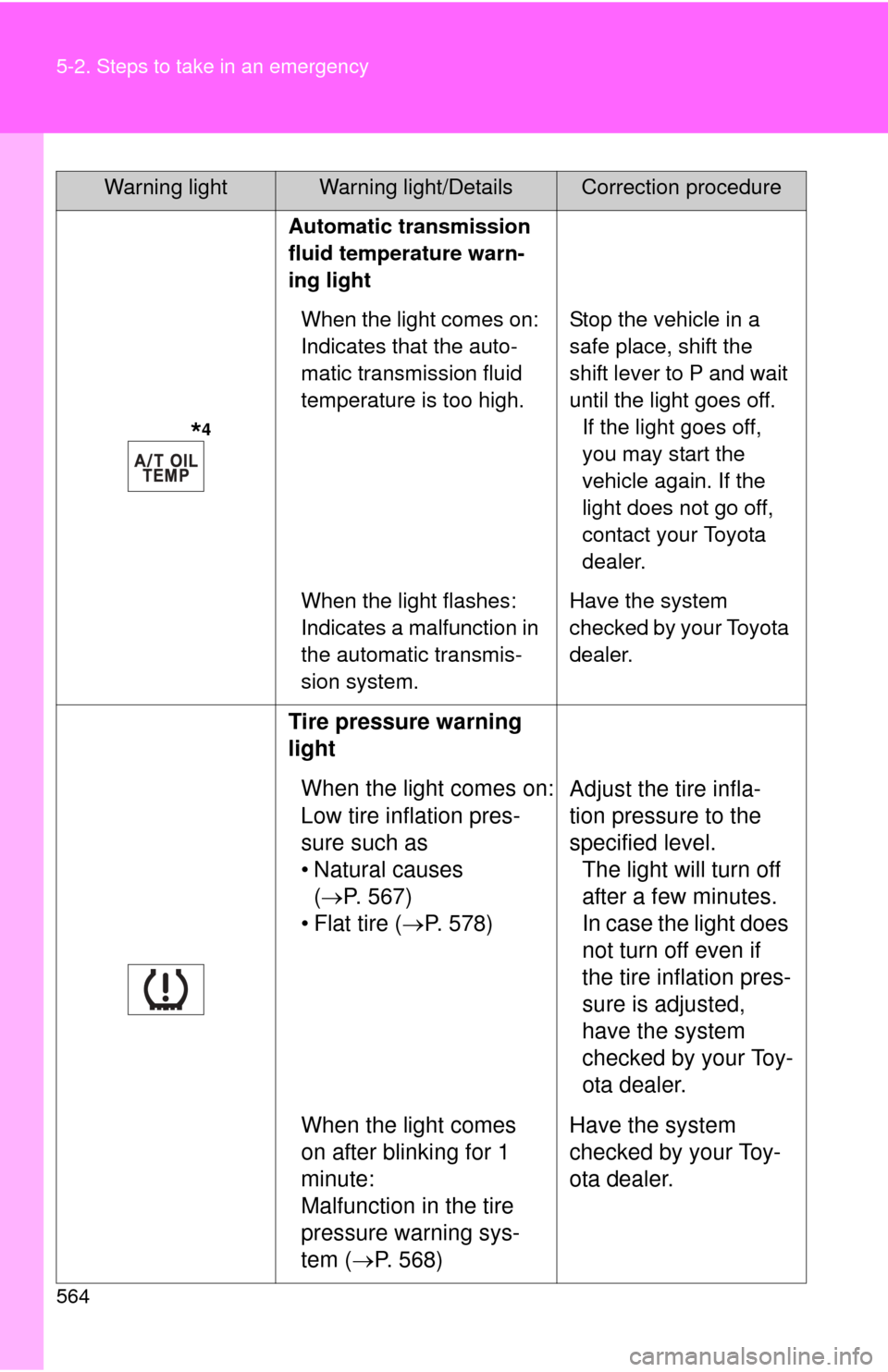
564 5-2. Steps to take in an emergency
*4
Automatic transmission
fluid temperature warn-
ing lightWhen the light comes on:
Indicates that the auto-
matic transmission fluid
temperature is too high. Stop the vehicle in a
safe place, shift the
shift lever to P and wait
until the light goes off.
If the light goes off,
you may start the
vehicle again. If the
light does not go off,
contact your Toyota
dealer.
When the light flashes:
Indicates a malfunction in
the automatic transmis-
sion system. Have the system
checked by your Toyota
dealer.
Tire pressure warning
light
When the light comes on:
Low tire inflation pres-
sure such as
• Natural causes ( P. 567)
• Flat tire ( P. 578) Adjust the tire infla-
tion pressure to the
specified level.
The light will turn off
after a few minutes.
In case the light does
not turn off even if
the tire inflation pres-
sure is adjusted,
have the system
checked by your Toy-
ota dealer.
When the light comes
on after blinking for 1
minute:
Malfunction in the tire
pressure warning sys-
tem ( P. 568) Have the system
checked by your Toy-
ota dealer.
Warning lightWarning light/DetailsCorrection procedure
Page 570 of 668
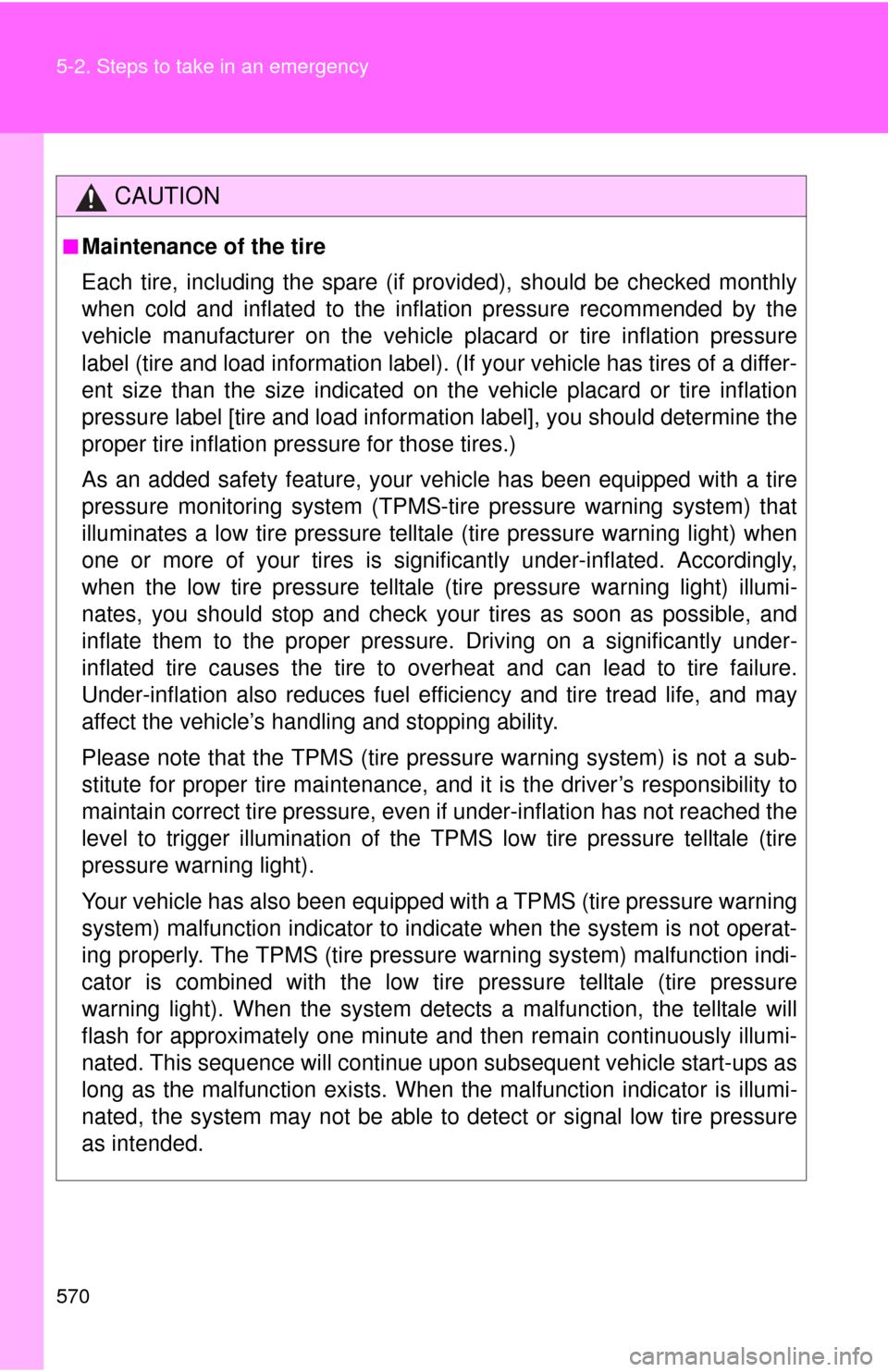
570 5-2. Steps to take in an emergency
CAUTION
■Maintenance of the tire
Each tire, including the spare (if provided), should be checked monthly
when cold and inflated to the inflation pressure recommended by the
vehicle manufacturer on the vehicle placard or tire inflation pressure
label (tire and load information label). (If your vehicle has tires of a differ-
ent size than the size indicated on the vehicle placard or tire inflation
pressure label [tire and load information label], you should determine the
proper tire inflation pr essure for those tires.)
As an added safety feature, your vehicle has been equipped with a tire
pressure monitoring system (TPMS-ti re pressure warning system) that
illuminates a low tire pressure telltal e (tire pressure warning light) when
one or more of your tires is significantly under-inflated. Accordingly,
when the low tire pressu re telltale (tire pressure warning light) illumi-
nates, you should stop and check your tires as soon as possible, and
inflate them to the proper pressure. Driving on a significantly under-
inflated tire causes the tire to overheat and can lead to tire failure.
Under-inflation also reduces fuel effi ciency and tire tread life, and may
affect the vehicle’s handling and stopping ability.
Please note that the TPMS (tire pressure warning system) is not a sub-
stitute for proper tire main tenance, and it is the driver’s responsibility to
maintain correct tire pressure, even if under-inflation has not reached the
level to trigger illu mination of the TPMS low tire pressure telltale (tire
pressure warning light).
Your vehicle has also been equipped with a TPMS (tire pressure warning
system) malfunction indicator to indi cate when the system is not operat-
ing properly. The TPMS (tire pressure warning system) malfunction indi-
cator is combined with the low tire pressure telltale (tire pressure
warning light). When the system det ects a malfunction, the telltale will
flash for approximately one minute an d then remain continuously illumi-
nated. This sequence will continue upon subsequent vehicle start-ups as
long as the malfunction exists. When the malfunction indi cator is illumi-
nated, the system may not be able to detect or signal low tire pressure
as intended.
Page 574 of 668
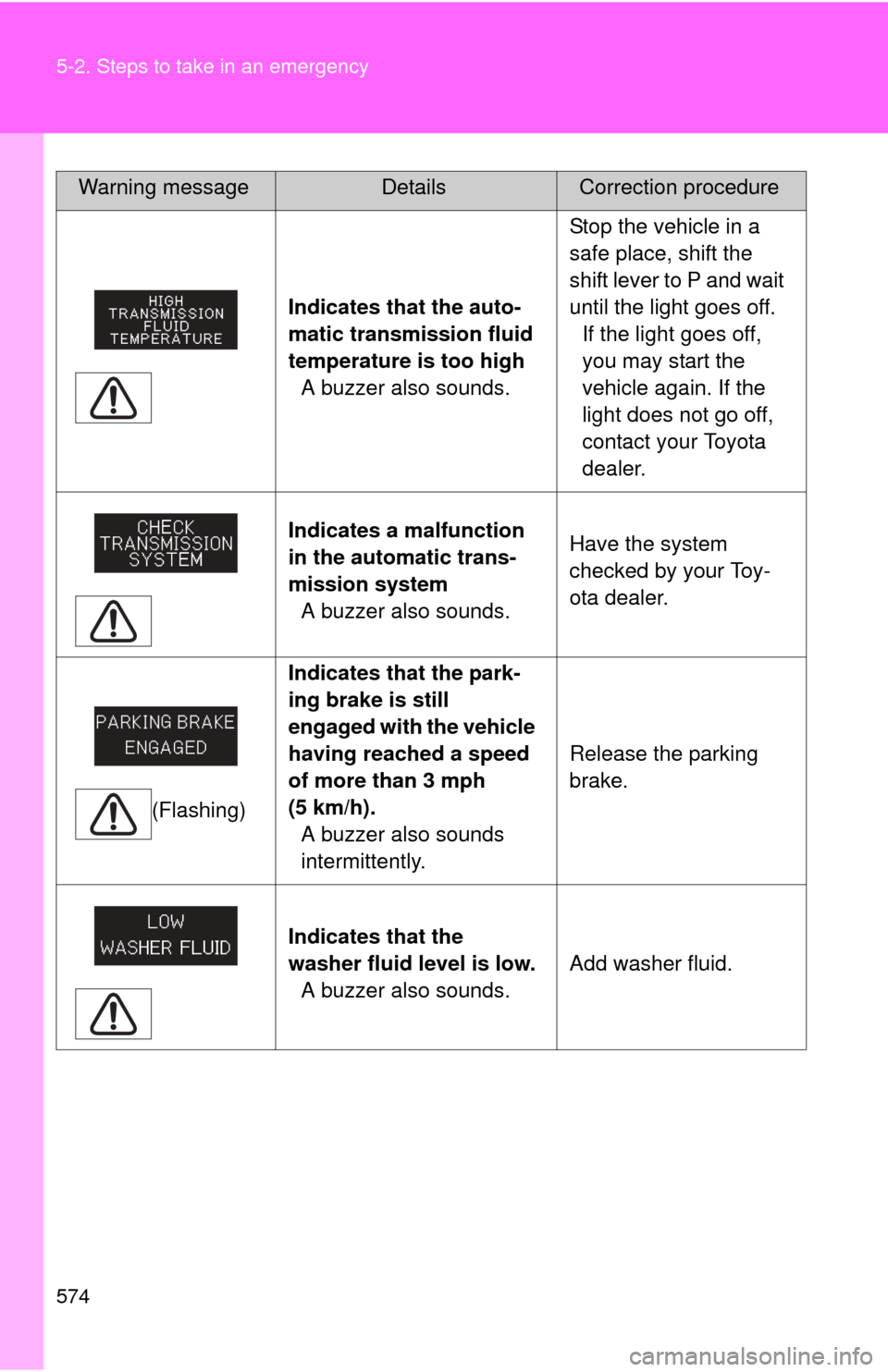
574 5-2. Steps to take in an emergency
Indicates that the auto-
matic transmission fluid
temperature is too highA buzzer also sounds. Stop the vehicle in a
safe place, shift the
shift lever to P and wait
until the light goes off.
If the light goes off,
you may start the
vehicle again. If the
light does not go off,
contact your Toyota
dealer.
Indicates a malfunction
in the automatic trans-
mission system A buzzer also sounds. Have the system
checked by your Toy-
ota dealer.
(Flashing) Indicates that the park-
ing brake is still
engaged with the vehicle
having reached a speed
of more than 3 mph
(5 km/h).
A buzzer also sounds
intermittently. Release the parking
brake.
Indicates that the
washer fluid level is low. A buzzer also sounds. Add washer fluid.
Warning messageDetailsCorrection procedure
Page 597 of 668
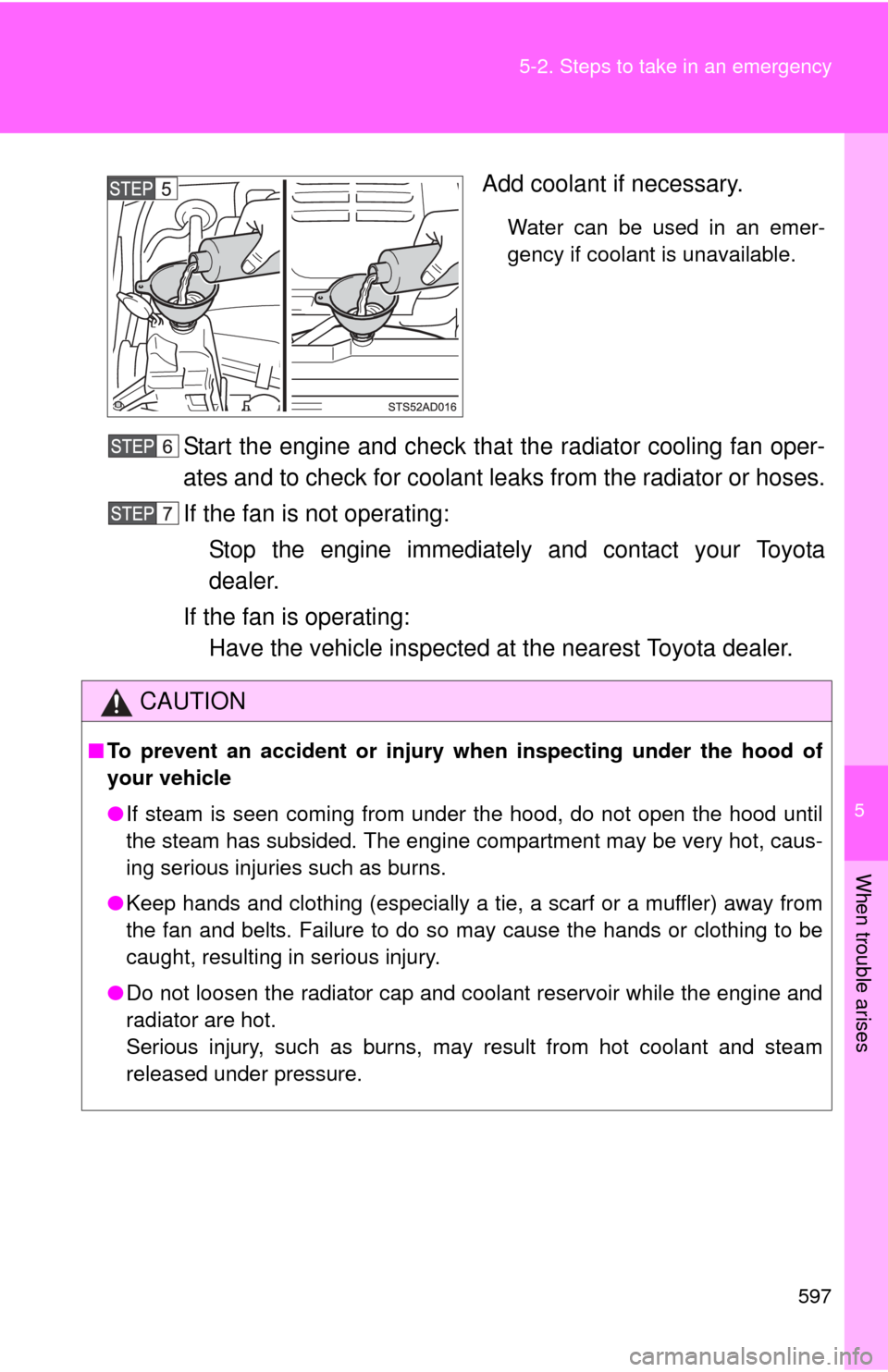
5
When trouble arises
597
5-2. Steps to take in an emergency
Add coolant if necessary.
Water can be used in an emer-
gency if coolant is unavailable.
Start the engine and check that the radiator cooling fan oper-
ates and to check for coolant le
aks from the radiator or hoses.
If the fan is not operating: Stop the engine immediately and contact your Toyota
dealer.
If the fan is operating: Have the vehicle inspected at the nearest Toyota dealer.
CAUTION
■To prevent an accident or injury when inspecting under the hood of
your vehicle
●If steam is seen coming from under the hood, do not open the hood until
the steam has subsided. The engine compartment may be very hot, caus-
ing serious injuries such as burns.
● Keep hands and clothing (especially a tie, a scarf or a muffler) away from
the fan and belts. Failure to do so may cause the hands or clothing to be
caught, resulting in serious injury.
● Do not loosen the radiator cap and coolant reservoir while the engine and
radiator are hot.
Serious injury, such as burns, may result from hot coolant and steam
released under pressure.
Page 599 of 668
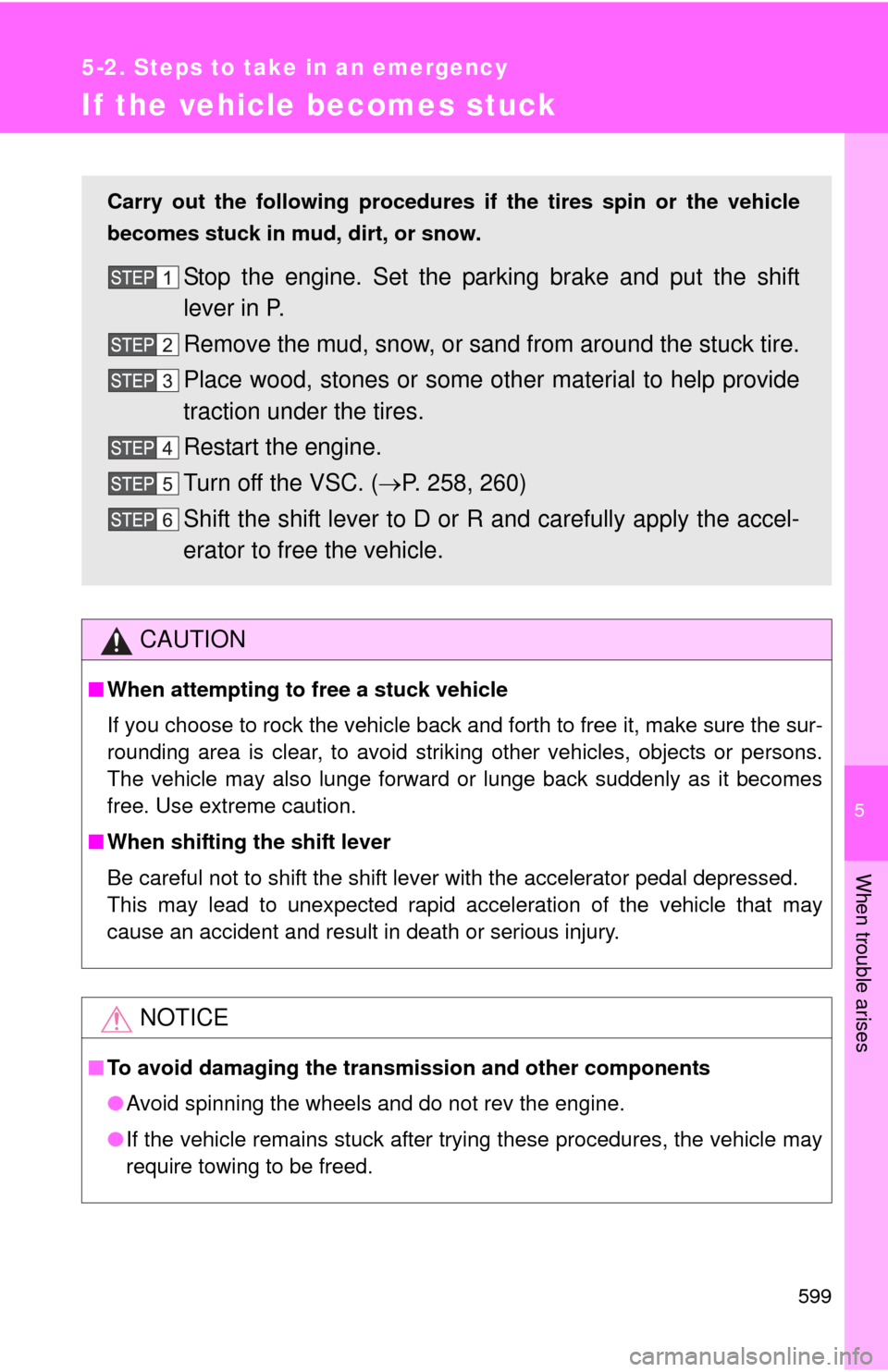
5
When trouble arises
599
5-2. Steps to take in an emergency
If the vehicle becomes stuck
CAUTION
■When attempting to free a stuck vehicle
If you choose to rock the vehicle back and forth to free it, make sure the sur-
rounding area is clear, to avoid striking other vehicles, objects or persons.
The vehicle may also lunge forward or lunge back suddenly as it becomes
free. Use extreme caution.
■ When shifting the shift lever
Be careful not to shift the shift lever with the accelerator pedal depressed.
This may lead to unexpected rapid acceleration of the vehicle that may
cause an accident and result in death or serious injury.
NOTICE
■To avoid damaging the transmission and other components
●Avoid spinning the wheels and do not rev the engine.
● If the vehicle remains stuck after trying these procedures, the vehicle may
require towing to be freed.
Carry out the following procedures if the tires spin or the vehicle
becomes stuck in mud, dirt, or snow.
Stop the engine. Set the parking brake and put the shift
lever in P.
Remove the mud, snow, or sand from around the stuck tire.
Place wood, stones or some other material to help provide
traction under the tires.
Restart the engine.
Turn off the VSC. ( P. 258, 260)
Shift the shift lever to D or R and carefully apply the accel-
erator to free the vehicle.
Page 658 of 668

658 Alphabetical index
Cruise controlCruise control ........................ 202
Dynamic laser cruise
control ................................. 206
Cup holders .............................. 426
Curtain shield airbags ............. 112
Customizable features............. 631
Daytime running light system .................................... 191
Defogger Rear window ......................... 317
Side mirrors ........................... 317
Dimension................................. 604
Dinghy towing .......................... 301
Display Trip information ..................... 178
Warning message ................. 572
Do-it-yourself main tenance..... 488
Door courtesy lights Door courtesy lights .............. 406
Wattage ................................. 614
Doors Back door ................................40
Door glasses ...........................91
Door lock ...........................31, 35
Side doors ...............................35
Side mirrors .............................85
Driver’s seat belt reminder light ......................................... 563
Driving
Break-in tips .......................... 149
Correct posture ..................... 110
Procedures ............................ 148
Winter driving tips.................. 277
Driving position memory...........63
DVD player
*
Electronically modulated air suspension ............................ 244
Emergency flashers Switch ................................... 552
Emergency, in case of
If the engine will not start ...... 589
If the shift lever cannot be shifted from P ..................... 591
If the vehicle has discharged battery................................. 593
If the warning buzzer
sounds ................................ 561
If the warning light turns on........................................ 561
If the warning message is displayed ............................ 572
If you have a flat tire ............. 578
If you lose your keys ............. 592
If you think something is wrong .................................. 559
If your vehicle becomes stuck ................................... 599
If your vehicle has to
be stopped in an
emergency .......................... 600
If your vehicle needs to be
towed .................................. 553
If your vehicle overheats ....... 596
Engine
Compartment ........................ 493
Engine switch ........................ 158
Hood ..................................... 492
How to start the engine ................................. 158
Identification number............. 606
If the engine will not start ...... 589
Ignition switch ...................... 158
Overheating .......................... 596
D
E